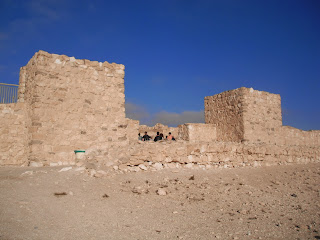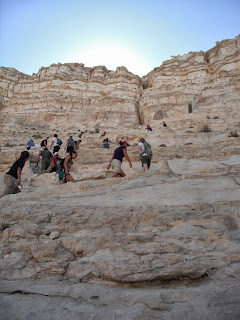Today was packed full of learning, so I doubt that I’ll be able
to touch on everything. We started out at Tel Arad. It is interesting at this
site how the different periods of time each have their own area and are very
distinct from each other. We started out in the Israelite fortress on top of
the tel. The temple that was found there was blocked off because they had been
digging through that to see other layers, so we couldn’t walk about inside
there.
At this small temple they found quite a few interesting things.
In addition to finding an altar and a holy of holies, there were also two
incense altars and three standing stones were also found there. The two
separate incense altars seem to suggest that there was worship to more than one
deity in this temple. They know that God
was worshipped here, but it appears that there was another god worshipped here
too.
A little ways
way they found a storage jar with an inscription reading ‘to Yahweh and his
ashera’. I have to say that I found this slightly disturbing, but we talked
about the concepts of religions back in that time. The idea that there was many
gods was all over the place. Henotheism was in almost every single religion.
There was multiple gods and people chose one or any number of the gods to
worship depending on what they needed. The idea that there was only one
God would be a difficult idea to grasp. It was tried in Egypt once and it
didn’t take long after that Pharaoh died that the idea was discarded too.
Why was this
happening? Was it the idea of fertility gods? (it takes more than one...) Was
it tolerance of the neighboring religions or influence of them? Was it an idea
that was so deeply engrained in the people of that time that their worldview could
only see it that way? Whatever the reason change in Israel to what we
understand as strictly monotheism happened in the second temple period, and
this site was still during the first temple period. We are often too quick to
place the 2nd temple period on the first temple period practices and
in reality they are quite different.
This isn’t a
completely foreign concept. The past 500 years have had dramatic change on the
way that we view churches and understand theology. Once the church worshipped
as one, and now there are many different churches. Our ideas and practices have
also shifted and change and each new era believes that they finally have
understood what the Bible is really
teaching.
The
second stop of the day was that Tel Be’er-sheva, the site of Beersheba. This
site was quite well constructed and much can be seen. Outside the city gate
there is a well. Apparently they have dug at least 80m down and they were still
removing fill, there was probably a good 5-6 seconds between dropping a rock in
and hearing it hit the water in the bottom.
There is the story of Abraham securing a covenant at Beersheba
with Abimelek the king of Gerar. After that he plants a tamarisk tree. These
are quite fun trees! The looks kind of scraggily, almost like a weeping
evergreen. The needles of the tree are actually quite salty to the taste. These
trees are actually self watering. The salt attracts the water in the air in the
morning and it gathers on the needles and waters the tree. The tree still
requires some water to survive on, but it can survive quite well in arid places
such as Beersheba.
Trees
are an important image in the Middle East. They are quite well connected to
deities. If there is a tree, there is water, where there is water, there is
fertility, and where there is fertility there is divine activity. They are
starting to figure out that cultic sites often precede settlement. This isn’t new. Trees play an important role
since the beginning of time. There were two important trees in the Garden of
Eden. And tree motifs run throughout the Bible.
The
other idea that occurred to me is that Jesus says in Matthew 5: 13 “You are the
salt of the earth. But if the salt loses its saltiness, how can it be made
salty again? It is no longer good for anything, except to be thrown out and
trampled underfoot.” In Jesus’ reference
to being salty could he be thinking of that Tamarisk tree that Abraham planted
at the southern part of the Promised Land? Salt that attracts the life giving
water. Trees that are a sign that my God is alive and active here! A Tamarisk
tree that is planted as a sign of looking forward to the future and settling
down here, in the place where God has called us.
Here are some pictures from the rest of the day.
 |
| Beersheba's water system |
Ibex
we went for a hike in Wadi Zin
Up the cliff, it is a lot of stairs
Stopped at Avdat there was remains of a Byzantine settlement far in the South. We tried to see how many we could fit in the baptismal. We could have fit more.
Machtesh Rammon - the world largest erosion crater

















what interesting stuff, I really like the Tamarisk story, but agree with you that it is disturbing when at Arad they worshiped not only our God
ReplyDeleteI also really liked the tamarisk story and liked your insights into Matt. 5. We're currently going through the Sermon on the Mount and Stephen and I spent much conversation discussing what it would mean for salt to loose its saltiness. I'll have to mention your thoughts to him. :)
Delete